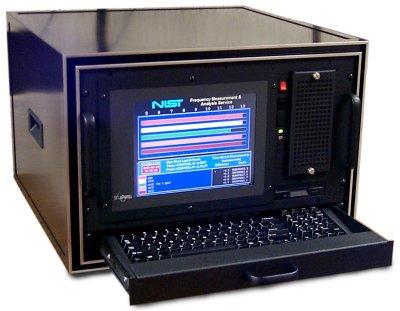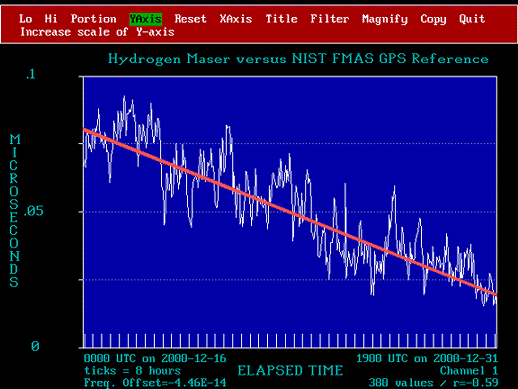Summary
The NIST Frequency Measurement and Analysis Service (FMAS) makes it easy to measure and calibrate any quartz, rubidium, cesium, or hydrogen maser frequency standard. The service can measure any frequency from 1 Hz to 120 MHz in 1 Hz increments. This means you can measure standard output frequencies like 5 and 10 MHz, telecommunication frequencies like 1.544, 2.048, and 51.84 MHz, and even 1 Hz timing pulses. As many as five devices can be measured and calibrated at once, even if all five have different output frequencies. And since the FMAS uses Global Positioning System (GPS) signals as its reference frequency, it will work anywhere on earth. All measurements are made automatically, and are traceable to the International System (SI) of units through UTC(NIST) at an uncertainty of 2 x 10-13 per day. The service is listed in the BIPM's key comparison database.
Description

Subscribers to the NIST service receive a complete frequency measurement system which includes everything needed to make precision frequency measurements that are traceable to NIST. An easy-to-read instruction manual makes installation a snap. Once the system is installed, it's easy to get started. Simply plug in the frequency standards you want to measure, and connect the system to a dedicated phone line. Up to five frequency standards can be measured and calibrated at once. The phone line allows NIST personnel to call your system, verify and analyze your data, and quickly troubleshoot any problems that may occur. If any part of the system fails, NIST quickly replaces it using an overnight delivery service.
The system uses GPS signals as a reference frequency. The GPS signals provide traceability to NIST, since the same GPS signals received by subscribers are received at NIST and compared to the national frequency standard. The GPS receiver is software controlled and requires no operator attention. Your only requirement is to mount a small antenna in a location which has a clear view of the sky.
The measurement system blends commercially-available equipment with hardware and software developed at NIST. Measurements are made using a time interval counter with a single shot resolution of less than 30 picoseconds. The software completely automates the measurement process. It presents the measurement data in a clear, easy-to-understand format.

While measurements are being made, a full-color bar graph displays the performance of each frequency standard over the last 24 hours. This bar graph is updated every hour. It lets you see at a glance how well each standard is performing. Every 24 hours (at a time that you select) the system prints a full-page graph of each standard's performance. The graph documents the calibration in case questions arise in the future. You can also print a statistical summary of the data, or a listing of the data in tabular form.
The software allows you to graph the performance of a frequency standard over periods ranging from 2 seconds to 150 days. An array of powerful graphing features let you display the data in a variety of fashions: you can increase or decrease the scale of the y-axis, or "zoom in" on sections of the graph to show as much detail as possible. Plus, a powerful FILTER feature is included that automatically removes outliers and phase steps if you choose to do so.
All data recorded by the system is stored on a solid state disk. At any time, you can retrieve and graph past data recorded by the system. This gives you a permanent history of all frequency calibrations made by your laboratory.
NIST regularly checks each system by modem to insure proper operation. NIST verifies the data from each system, and mails each subscriber a monthly calibration report that certifies that their primary frequency standard is traceable to NIST. The calibration report includes a graph of the primary standard's performance, and a statement of measurement uncertainty.
| Specifications for NIST FMAS | |
|---|---|
| Measurement Channels | Up to 5 frequency standards can be calibrated at one time. The FMAS will accept any input frequency from 1 Hz to 120 MHz in 1 Hz increments. |
| Measurement Resolution | < 30 ps |
| Frequency Uncertainty with GPS | 2 x 10-13 (24 hour averaging time) |
| Frequency Uncertainty (direct comparisons) | 2 x 10-15 (24 hour averaging time) |
| Data Collection | The FMAS records data points using 1 hour averages in long term mode, and 1 second averages in short term mode. Up to 3600 data points can be plotted on one graph. |
NIST assesses the quality of the FMAS every five years, and a documented quality system for the service is maintained in compliance with the ISO 17025 standard. The service complies with the requirements of NVLAP (National Voluntary Laboratory Accreditation Program), and FMAS subscribers who seek accreditation in the frequency calibration field can reduce or eliminate the proficiency testing and on-site assessment fees charged by NVLAP. In addition, the FMAS is internationally recognized by the Bureau International des Poids et Mesures (BIPM) and is included in their Key Comparison Database (KCDB).
The FMAS is a welcome addition to any laboratory that performs frequency calibrations. The service provides a complete solution to all frequency measurement and calibration problems.
| Pricing and Delivery Information for NIST FMAS | ||
|---|---|---|
| NIST Service ID Number | 76100C | For a listing of all NIST calibration services, see the NIST E-Commerce Storefront. |
| Monthly Service Fee | $687 | This comprehensive fee covers technical support, equipment replacement, data analysis, and all necessary supplies. |
| Payment | Subscribers issue a purchase order for the startup fee and at least 1 year of service. Invoices are sent quarterly and in arrears. For example, after subscribing to the service for 3 months, you'll receive an invoice for $1890 (for the service already received). The service can be cancelled at any time. | |
| Delivery | Delivery takes place within 2-4 weeks of receipt of an order. | |
For more information about the NIST Frequency Measurement and Analysis Service, see the following PDF files:
An Introduction to Frequency Calibrations
(Appendix A from the Operator's manual (NISTIR 6610), a tutorial on frequency calibrations)

